Management Accounting Systems, Techniques & Financial Reporting
VerifiedAdded on 2024/06/07
|21
|4415
|400
Report
AI Summary
This report provides a detailed overview of management accounting principles and techniques used for planning and strategic purposes within a medium-sized manufacturing organization. It explains management accounting systems, their application in an organizational context, and the differences between management and financial accounting. The report covers cost accounting systems, inventory management systems, and job costing systems, illustrating each with examples. It also explains various management report methods, such as cost accounting, budget, financial, accounts receivable, and accounts payable reports, highlighting their importance. Furthermore, the document includes a detailed explanation of absorption and marginal costing techniques, with income statements produced using both methods, and delves into planning tools and techniques for making plans and solving financial problems. Finally, the report discusses the merits and demerits of budgetary control, applications of planning tools in budget preparation, and how management accounting helps organizations overcome financial problems and achieve sustainable success. Desklib provides access to this report and many other solved assignments.
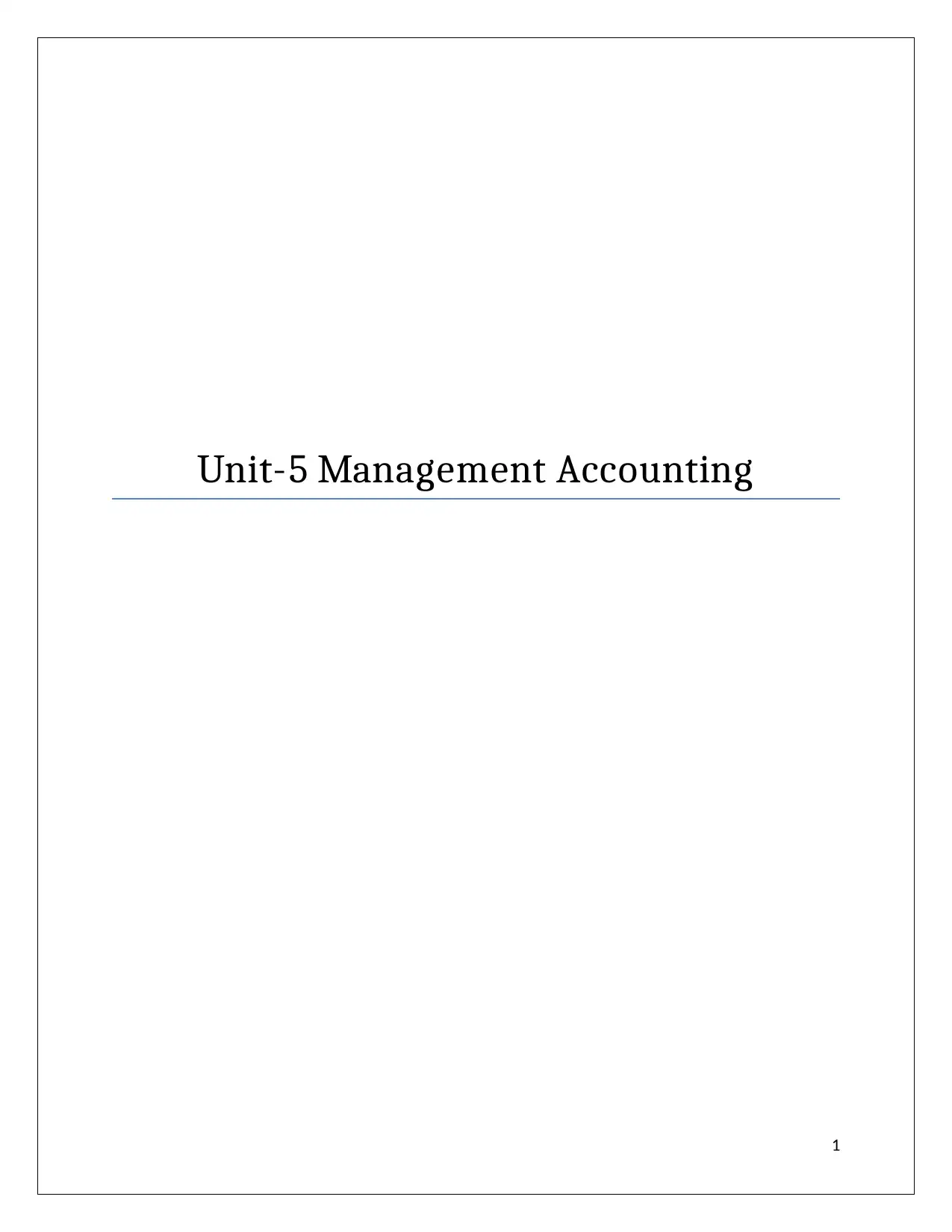
Unit-5 Management Accounting
1
1
Paraphrase This Document
Need a fresh take? Get an instant paraphrase of this document with our AI Paraphraser
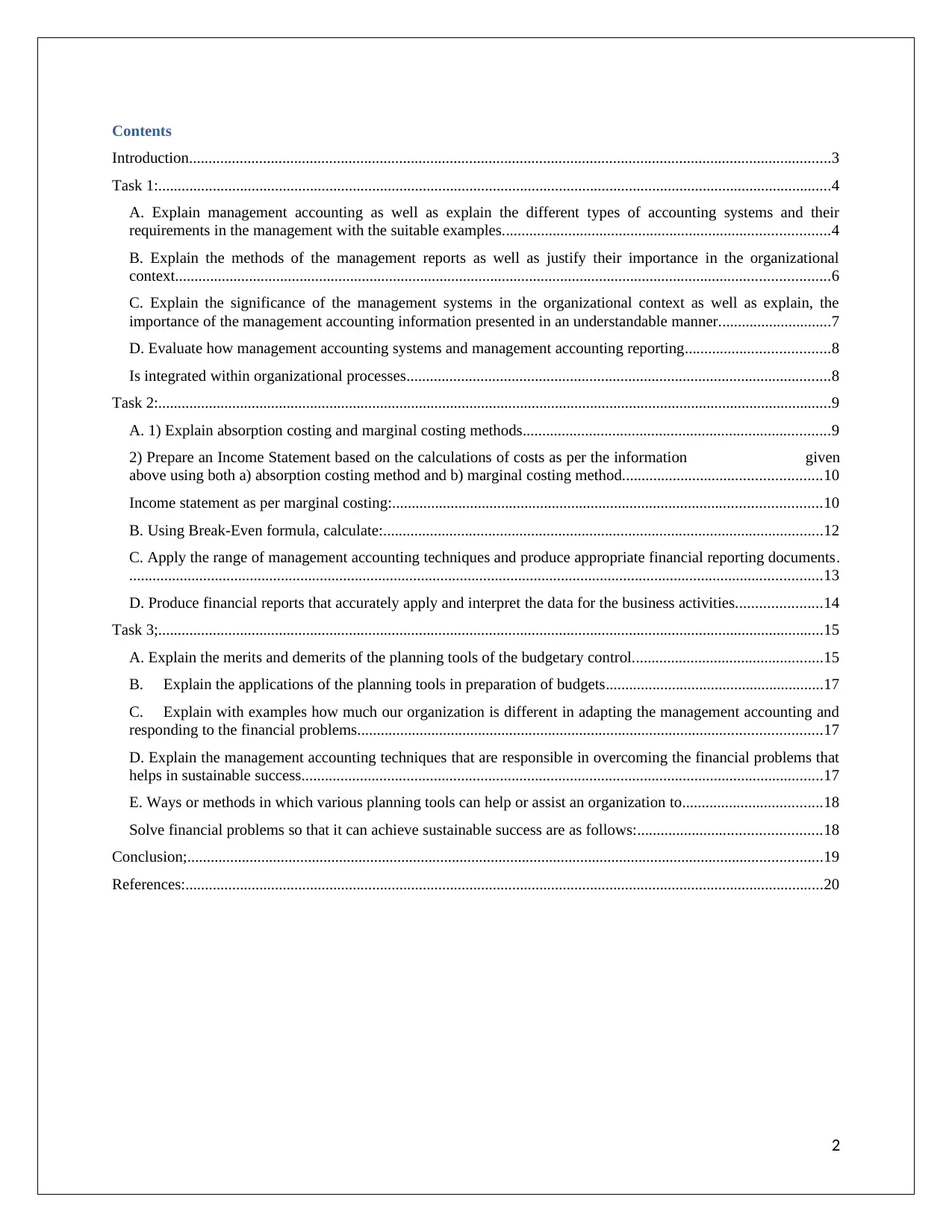
Contents
Introduction.....................................................................................................................................................................3
Task 1:.............................................................................................................................................................................4
A. Explain management accounting as well as explain the different types of accounting systems and their
requirements in the management with the suitable examples....................................................................................4
B. Explain the methods of the management reports as well as justify their importance in the organizational
context........................................................................................................................................................................6
C. Explain the significance of the management systems in the organizational context as well as explain, the
importance of the management accounting information presented in an understandable manner.............................7
D. Evaluate how management accounting systems and management accounting reporting.....................................8
Is integrated within organizational processes.............................................................................................................8
Task 2:.............................................................................................................................................................................9
A. 1) Explain absorption costing and marginal costing methods...............................................................................9
2) Prepare an Income Statement based on the calculations of costs as per the information given
above using both a) absorption costing method and b) marginal costing method...................................................10
Income statement as per marginal costing:..............................................................................................................10
B. Using Break-Even formula, calculate:.................................................................................................................12
C. Apply the range of management accounting techniques and produce appropriate financial reporting documents.
..................................................................................................................................................................................13
D. Produce financial reports that accurately apply and interpret the data for the business activities......................14
Task 3;...........................................................................................................................................................................15
A. Explain the merits and demerits of the planning tools of the budgetary control.................................................15
B. Explain the applications of the planning tools in preparation of budgets........................................................17
C. Explain with examples how much our organization is different in adapting the management accounting and
responding to the financial problems.......................................................................................................................17
D. Explain the management accounting techniques that are responsible in overcoming the financial problems that
helps in sustainable success......................................................................................................................................17
E. Ways or methods in which various planning tools can help or assist an organization to....................................18
Solve financial problems so that it can achieve sustainable success are as follows:...............................................18
Conclusion;...................................................................................................................................................................19
References:....................................................................................................................................................................20
2
Introduction.....................................................................................................................................................................3
Task 1:.............................................................................................................................................................................4
A. Explain management accounting as well as explain the different types of accounting systems and their
requirements in the management with the suitable examples....................................................................................4
B. Explain the methods of the management reports as well as justify their importance in the organizational
context........................................................................................................................................................................6
C. Explain the significance of the management systems in the organizational context as well as explain, the
importance of the management accounting information presented in an understandable manner.............................7
D. Evaluate how management accounting systems and management accounting reporting.....................................8
Is integrated within organizational processes.............................................................................................................8
Task 2:.............................................................................................................................................................................9
A. 1) Explain absorption costing and marginal costing methods...............................................................................9
2) Prepare an Income Statement based on the calculations of costs as per the information given
above using both a) absorption costing method and b) marginal costing method...................................................10
Income statement as per marginal costing:..............................................................................................................10
B. Using Break-Even formula, calculate:.................................................................................................................12
C. Apply the range of management accounting techniques and produce appropriate financial reporting documents.
..................................................................................................................................................................................13
D. Produce financial reports that accurately apply and interpret the data for the business activities......................14
Task 3;...........................................................................................................................................................................15
A. Explain the merits and demerits of the planning tools of the budgetary control.................................................15
B. Explain the applications of the planning tools in preparation of budgets........................................................17
C. Explain with examples how much our organization is different in adapting the management accounting and
responding to the financial problems.......................................................................................................................17
D. Explain the management accounting techniques that are responsible in overcoming the financial problems that
helps in sustainable success......................................................................................................................................17
E. Ways or methods in which various planning tools can help or assist an organization to....................................18
Solve financial problems so that it can achieve sustainable success are as follows:...............................................18
Conclusion;...................................................................................................................................................................19
References:....................................................................................................................................................................20
2

Introduction
The preparation of following report is concerned with obtaining a detailed knowledge about the
management accounting principles and techniques that can be used in an organisation for
planning and strategically purposes. The use of management accounting traditionally was limited
for the purpose of presenting information to the management but in modern business
environment they same has been used for producing value added reports for business managers
and assisting them in taking critical business decisions. The report will involve an explanation
regarding the management accounting systems and their application in an organizational context.
The organisation selected here will be a medium sized organisation which is operating in
manufacturing industry. The report will include the detailed explanation regarding the two
techniques of costing covering absorption costing and marginal costing. The income statements
will be produced based on these techniques. Further the report will also include a detailed
knowledge about the various planning tools and techniques that can be used in an enterprise for
making plans and solving the financial problems.
3
The preparation of following report is concerned with obtaining a detailed knowledge about the
management accounting principles and techniques that can be used in an organisation for
planning and strategically purposes. The use of management accounting traditionally was limited
for the purpose of presenting information to the management but in modern business
environment they same has been used for producing value added reports for business managers
and assisting them in taking critical business decisions. The report will involve an explanation
regarding the management accounting systems and their application in an organizational context.
The organisation selected here will be a medium sized organisation which is operating in
manufacturing industry. The report will include the detailed explanation regarding the two
techniques of costing covering absorption costing and marginal costing. The income statements
will be produced based on these techniques. Further the report will also include a detailed
knowledge about the various planning tools and techniques that can be used in an enterprise for
making plans and solving the financial problems.
3
⊘ This is a preview!⊘
Do you want full access?
Subscribe today to unlock all pages.

Trusted by 1+ million students worldwide

Task 1:
A. Explain management accounting as well as explain the different types of accounting
systems and their requirements in the management with the suitable examples.
The term management accounting refers to the set of accounting conducted in an enterprise for
producing appropriate reports that can be used by management in decision making purposes. The
process of management accounting involves identifying the critical sources of information and
recording and presenting the data in a report format in order to provide accurate and timely
information to the management. The information will thus be utilized for the purpose of making
economic decision in the company. The system of management accounting will be used in a
manufacturing organisation in order to keep record of manufacturing operations of the company
and analysing the efficiency and effectiveness with which they are conducted (Charles, et. al.,
2017).
Difference between management accounting and financial accounting:
Objective – The objective of management accounting is to assist business managers in taking
significant decision regarding the company. The reports will be utilized for evaluating and
analysing the performance of company and the decision will be taken accordingly. However
financial accounting is the form of accounting in which financial reports are presented to the
investors and other outsiders in order to assist them in taking their investment decisions.
Users – The users which are concerned with management accounting reports are associated with
internal people of the organisation consisting of employees, managers etc. whereas the financial
accounting reports are used by external people of organisation consisting of investors, creditors
etc.
Frequency of reporting – The management accounting reports can be prepared at the will of the
management and there is no boundation for preparing the same at a regular interval if time.
However the financial reports are subjected to regulations in which the periodical reports must be
prepared by the management in order to present the same before users (Carley and Christie,
2017).
4
A. Explain management accounting as well as explain the different types of accounting
systems and their requirements in the management with the suitable examples.
The term management accounting refers to the set of accounting conducted in an enterprise for
producing appropriate reports that can be used by management in decision making purposes. The
process of management accounting involves identifying the critical sources of information and
recording and presenting the data in a report format in order to provide accurate and timely
information to the management. The information will thus be utilized for the purpose of making
economic decision in the company. The system of management accounting will be used in a
manufacturing organisation in order to keep record of manufacturing operations of the company
and analysing the efficiency and effectiveness with which they are conducted (Charles, et. al.,
2017).
Difference between management accounting and financial accounting:
Objective – The objective of management accounting is to assist business managers in taking
significant decision regarding the company. The reports will be utilized for evaluating and
analysing the performance of company and the decision will be taken accordingly. However
financial accounting is the form of accounting in which financial reports are presented to the
investors and other outsiders in order to assist them in taking their investment decisions.
Users – The users which are concerned with management accounting reports are associated with
internal people of the organisation consisting of employees, managers etc. whereas the financial
accounting reports are used by external people of organisation consisting of investors, creditors
etc.
Frequency of reporting – The management accounting reports can be prepared at the will of the
management and there is no boundation for preparing the same at a regular interval if time.
However the financial reports are subjected to regulations in which the periodical reports must be
prepared by the management in order to present the same before users (Carley and Christie,
2017).
4
Paraphrase This Document
Need a fresh take? Get an instant paraphrase of this document with our AI Paraphraser
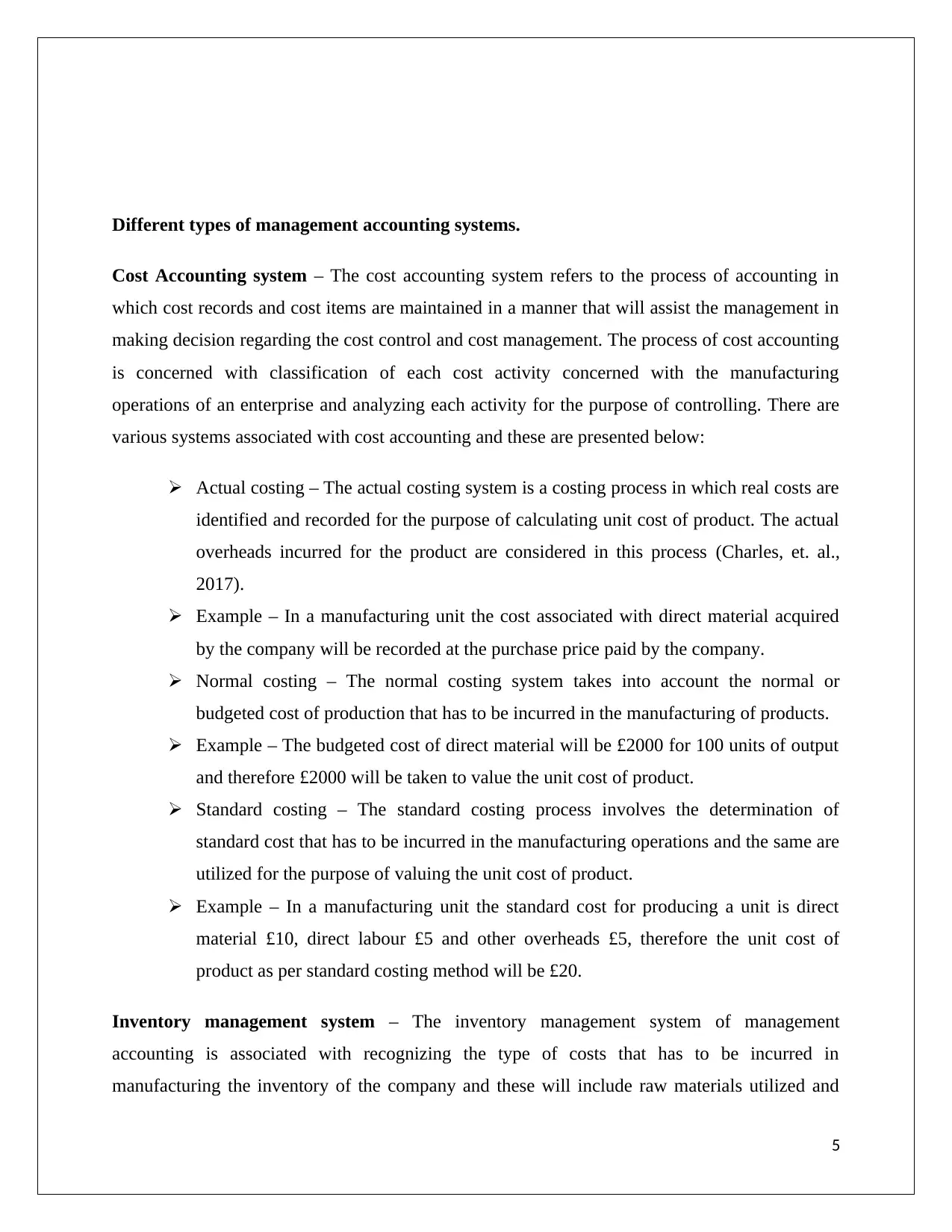
Different types of management accounting systems.
Cost Accounting system – The cost accounting system refers to the process of accounting in
which cost records and cost items are maintained in a manner that will assist the management in
making decision regarding the cost control and cost management. The process of cost accounting
is concerned with classification of each cost activity concerned with the manufacturing
operations of an enterprise and analyzing each activity for the purpose of controlling. There are
various systems associated with cost accounting and these are presented below:
Actual costing – The actual costing system is a costing process in which real costs are
identified and recorded for the purpose of calculating unit cost of product. The actual
overheads incurred for the product are considered in this process (Charles, et. al.,
2017).
Example – In a manufacturing unit the cost associated with direct material acquired
by the company will be recorded at the purchase price paid by the company.
Normal costing – The normal costing system takes into account the normal or
budgeted cost of production that has to be incurred in the manufacturing of products.
Example – The budgeted cost of direct material will be £2000 for 100 units of output
and therefore £2000 will be taken to value the unit cost of product.
Standard costing – The standard costing process involves the determination of
standard cost that has to be incurred in the manufacturing operations and the same are
utilized for the purpose of valuing the unit cost of product.
Example – In a manufacturing unit the standard cost for producing a unit is direct
material £10, direct labour £5 and other overheads £5, therefore the unit cost of
product as per standard costing method will be £20.
Inventory management system – The inventory management system of management
accounting is associated with recognizing the type of costs that has to be incurred in
manufacturing the inventory of the company and these will include raw materials utilized and
5
Cost Accounting system – The cost accounting system refers to the process of accounting in
which cost records and cost items are maintained in a manner that will assist the management in
making decision regarding the cost control and cost management. The process of cost accounting
is concerned with classification of each cost activity concerned with the manufacturing
operations of an enterprise and analyzing each activity for the purpose of controlling. There are
various systems associated with cost accounting and these are presented below:
Actual costing – The actual costing system is a costing process in which real costs are
identified and recorded for the purpose of calculating unit cost of product. The actual
overheads incurred for the product are considered in this process (Charles, et. al.,
2017).
Example – In a manufacturing unit the cost associated with direct material acquired
by the company will be recorded at the purchase price paid by the company.
Normal costing – The normal costing system takes into account the normal or
budgeted cost of production that has to be incurred in the manufacturing of products.
Example – The budgeted cost of direct material will be £2000 for 100 units of output
and therefore £2000 will be taken to value the unit cost of product.
Standard costing – The standard costing process involves the determination of
standard cost that has to be incurred in the manufacturing operations and the same are
utilized for the purpose of valuing the unit cost of product.
Example – In a manufacturing unit the standard cost for producing a unit is direct
material £10, direct labour £5 and other overheads £5, therefore the unit cost of
product as per standard costing method will be £20.
Inventory management system – The inventory management system of management
accounting is associated with recognizing the type of costs that has to be incurred in
manufacturing the inventory of the company and these will include raw materials utilized and
5

other costs. The inventory of the company can be in the form of work in progress or finished
goods of the company. There are various kinds of inventory systems utilized in the companies
some of which are explained below:
FIFO – The first in first out method of recording inventory is associated with the process
in which the oldest inventory is considered first to calculate the cost of goods sold. The
same helps in obtaining the actual cost incurred.
LIFO – The last in first put method considers the latest inventory purchased to value the
unit cost of product and therefore the updated cost of obtained.
JIT – Just in time is the inventory system in which the orders for purchases are placed as
soon as inventory becomes out of stock for the company (Carley and Christie, 2017).
Job costing system – The job costing system is the accounting system in which individual jobs
are identified which are received form customers and the cost records are maintained for each of
the job. The job costing system is not as same as the process costing system.
Example – In a manufacturing unit the job can be related with manufacturing the single product
and identifying the cost related with materials, labour and other overheads for producing the
product.
B. Explain the methods of the management reports as well as justify their importance in
the organizational context.
The different types of reports along with their importance are presented below:
Cost accounting report – The cost accounting reports contain the information about cost data of
the company and helps in classifying the cost according to nature and level of activity of
performed. The cost accounting reports is essential for presenting the right cost information
before the managers of company (Goetsch & Davis, 2014).
Budget report – The budget report will be concerned with presenting a statement about the cost
and revenues to be achieved by the company based on past and predicted data of the company.
The same helps in alloctai8ng the resources and controlling the activities in a manufacturing
organisation.
6
goods of the company. There are various kinds of inventory systems utilized in the companies
some of which are explained below:
FIFO – The first in first out method of recording inventory is associated with the process
in which the oldest inventory is considered first to calculate the cost of goods sold. The
same helps in obtaining the actual cost incurred.
LIFO – The last in first put method considers the latest inventory purchased to value the
unit cost of product and therefore the updated cost of obtained.
JIT – Just in time is the inventory system in which the orders for purchases are placed as
soon as inventory becomes out of stock for the company (Carley and Christie, 2017).
Job costing system – The job costing system is the accounting system in which individual jobs
are identified which are received form customers and the cost records are maintained for each of
the job. The job costing system is not as same as the process costing system.
Example – In a manufacturing unit the job can be related with manufacturing the single product
and identifying the cost related with materials, labour and other overheads for producing the
product.
B. Explain the methods of the management reports as well as justify their importance in
the organizational context.
The different types of reports along with their importance are presented below:
Cost accounting report – The cost accounting reports contain the information about cost data of
the company and helps in classifying the cost according to nature and level of activity of
performed. The cost accounting reports is essential for presenting the right cost information
before the managers of company (Goetsch & Davis, 2014).
Budget report – The budget report will be concerned with presenting a statement about the cost
and revenues to be achieved by the company based on past and predicted data of the company.
The same helps in alloctai8ng the resources and controlling the activities in a manufacturing
organisation.
6
⊘ This is a preview!⊘
Do you want full access?
Subscribe today to unlock all pages.

Trusted by 1+ million students worldwide
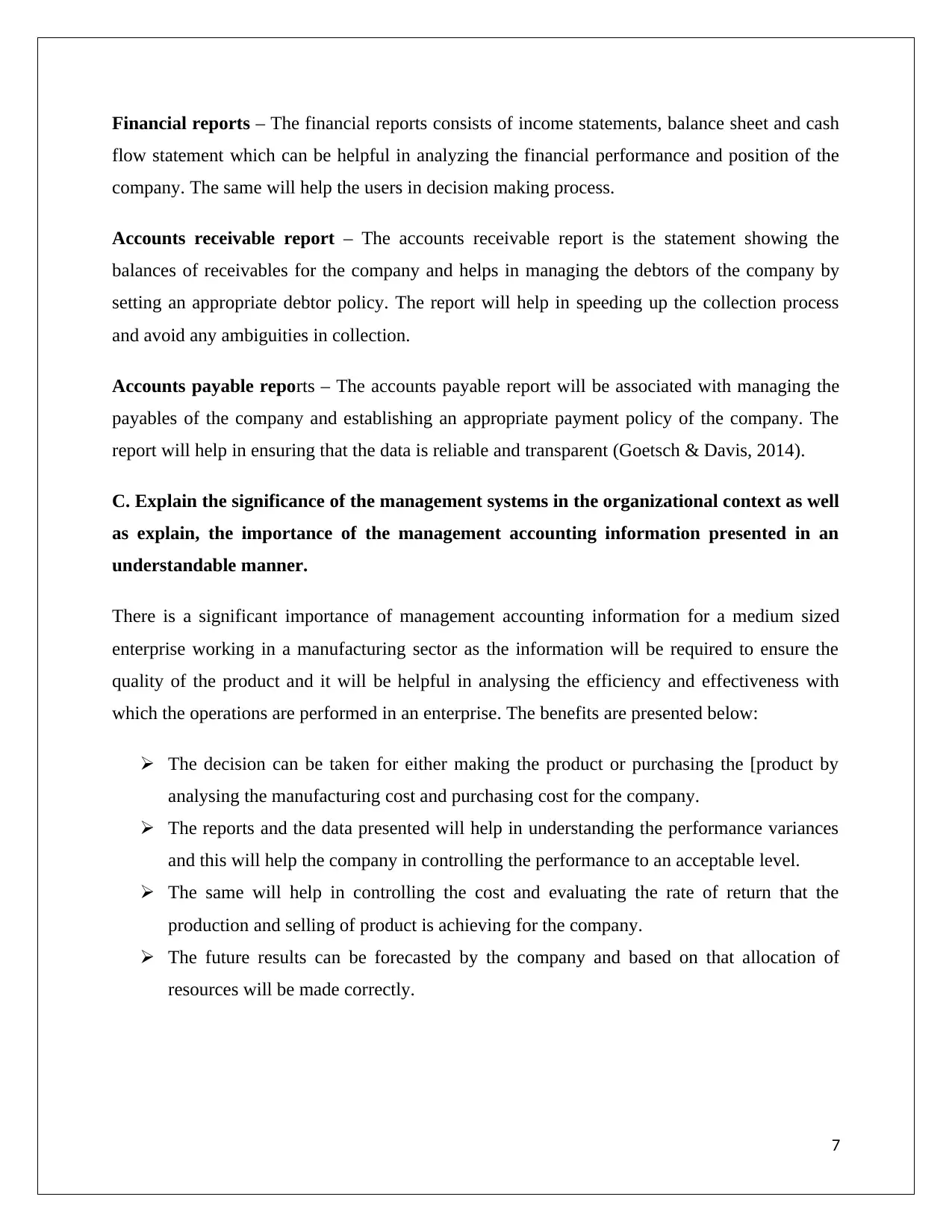
Financial reports – The financial reports consists of income statements, balance sheet and cash
flow statement which can be helpful in analyzing the financial performance and position of the
company. The same will help the users in decision making process.
Accounts receivable report – The accounts receivable report is the statement showing the
balances of receivables for the company and helps in managing the debtors of the company by
setting an appropriate debtor policy. The report will help in speeding up the collection process
and avoid any ambiguities in collection.
Accounts payable reports – The accounts payable report will be associated with managing the
payables of the company and establishing an appropriate payment policy of the company. The
report will help in ensuring that the data is reliable and transparent (Goetsch & Davis, 2014).
C. Explain the significance of the management systems in the organizational context as well
as explain, the importance of the management accounting information presented in an
understandable manner.
There is a significant importance of management accounting information for a medium sized
enterprise working in a manufacturing sector as the information will be required to ensure the
quality of the product and it will be helpful in analysing the efficiency and effectiveness with
which the operations are performed in an enterprise. The benefits are presented below:
The decision can be taken for either making the product or purchasing the [product by
analysing the manufacturing cost and purchasing cost for the company.
The reports and the data presented will help in understanding the performance variances
and this will help the company in controlling the performance to an acceptable level.
The same will help in controlling the cost and evaluating the rate of return that the
production and selling of product is achieving for the company.
The future results can be forecasted by the company and based on that allocation of
resources will be made correctly.
7
flow statement which can be helpful in analyzing the financial performance and position of the
company. The same will help the users in decision making process.
Accounts receivable report – The accounts receivable report is the statement showing the
balances of receivables for the company and helps in managing the debtors of the company by
setting an appropriate debtor policy. The report will help in speeding up the collection process
and avoid any ambiguities in collection.
Accounts payable reports – The accounts payable report will be associated with managing the
payables of the company and establishing an appropriate payment policy of the company. The
report will help in ensuring that the data is reliable and transparent (Goetsch & Davis, 2014).
C. Explain the significance of the management systems in the organizational context as well
as explain, the importance of the management accounting information presented in an
understandable manner.
There is a significant importance of management accounting information for a medium sized
enterprise working in a manufacturing sector as the information will be required to ensure the
quality of the product and it will be helpful in analysing the efficiency and effectiveness with
which the operations are performed in an enterprise. The benefits are presented below:
The decision can be taken for either making the product or purchasing the [product by
analysing the manufacturing cost and purchasing cost for the company.
The reports and the data presented will help in understanding the performance variances
and this will help the company in controlling the performance to an acceptable level.
The same will help in controlling the cost and evaluating the rate of return that the
production and selling of product is achieving for the company.
The future results can be forecasted by the company and based on that allocation of
resources will be made correctly.
7
Paraphrase This Document
Need a fresh take? Get an instant paraphrase of this document with our AI Paraphraser
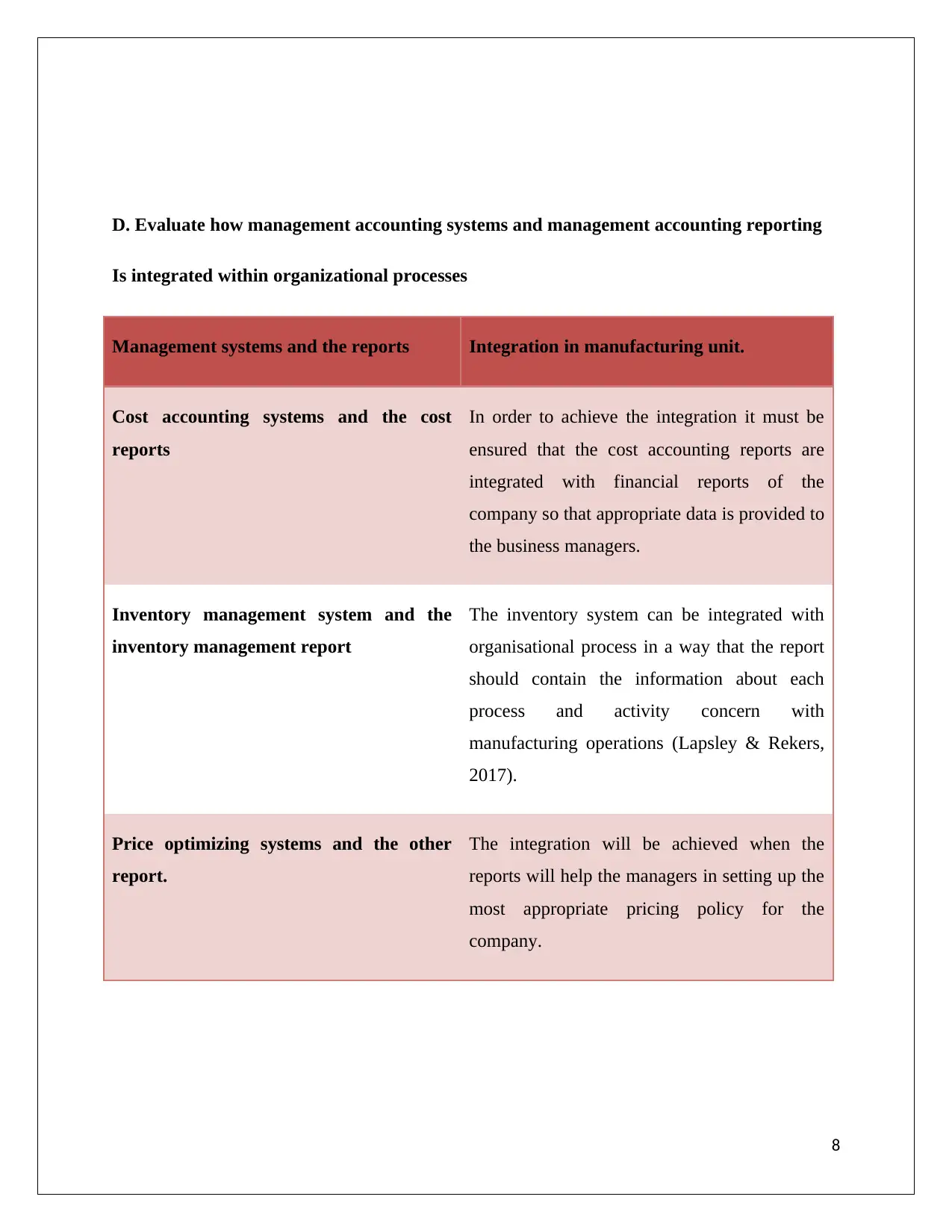
D. Evaluate how management accounting systems and management accounting reporting
Is integrated within organizational processes
Management systems and the reports Integration in manufacturing unit.
Cost accounting systems and the cost
reports
In order to achieve the integration it must be
ensured that the cost accounting reports are
integrated with financial reports of the
company so that appropriate data is provided to
the business managers.
Inventory management system and the
inventory management report
The inventory system can be integrated with
organisational process in a way that the report
should contain the information about each
process and activity concern with
manufacturing operations (Lapsley & Rekers,
2017).
Price optimizing systems and the other
report.
The integration will be achieved when the
reports will help the managers in setting up the
most appropriate pricing policy for the
company.
8
Is integrated within organizational processes
Management systems and the reports Integration in manufacturing unit.
Cost accounting systems and the cost
reports
In order to achieve the integration it must be
ensured that the cost accounting reports are
integrated with financial reports of the
company so that appropriate data is provided to
the business managers.
Inventory management system and the
inventory management report
The inventory system can be integrated with
organisational process in a way that the report
should contain the information about each
process and activity concern with
manufacturing operations (Lapsley & Rekers,
2017).
Price optimizing systems and the other
report.
The integration will be achieved when the
reports will help the managers in setting up the
most appropriate pricing policy for the
company.
8
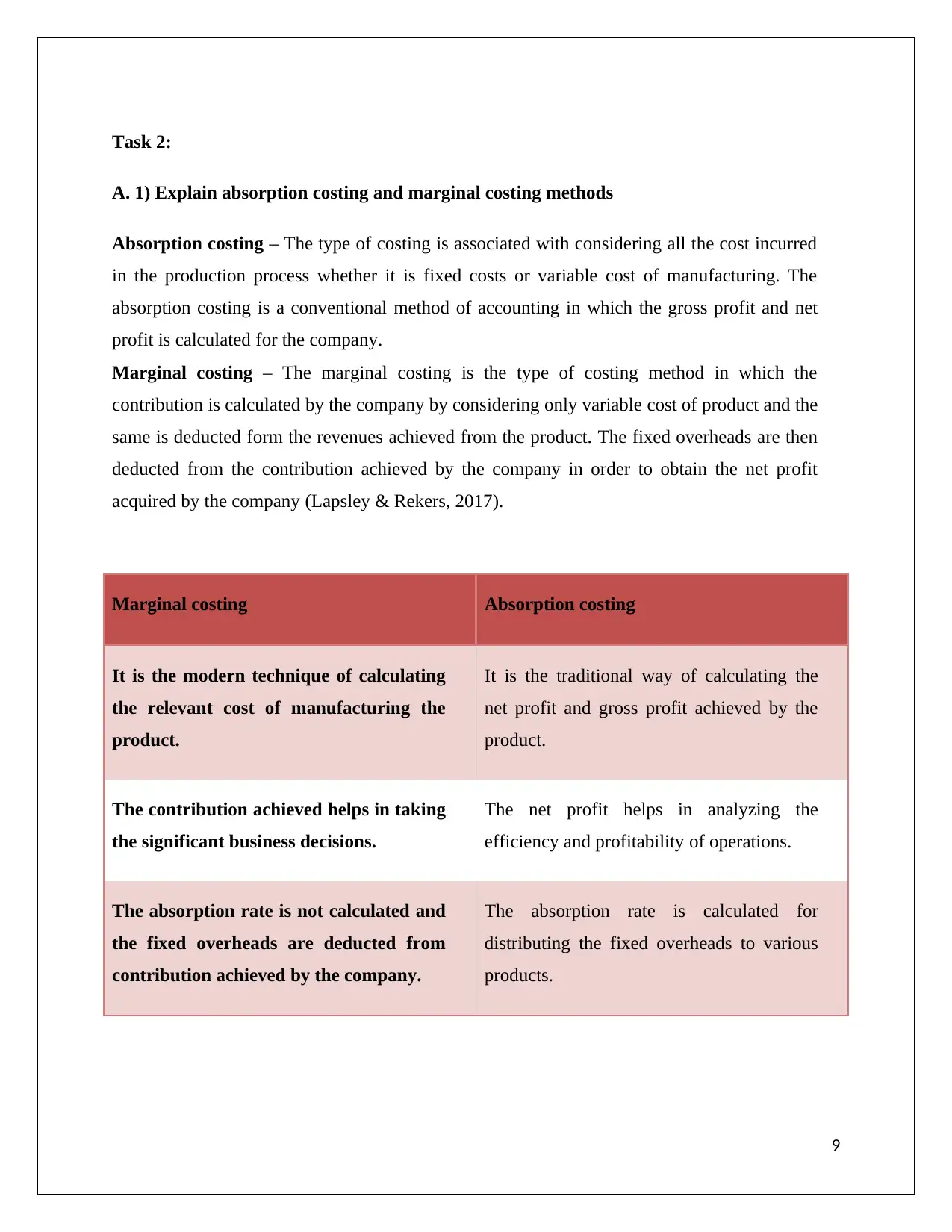
Task 2:
A. 1) Explain absorption costing and marginal costing methods
Absorption costing – The type of costing is associated with considering all the cost incurred
in the production process whether it is fixed costs or variable cost of manufacturing. The
absorption costing is a conventional method of accounting in which the gross profit and net
profit is calculated for the company.
Marginal costing – The marginal costing is the type of costing method in which the
contribution is calculated by the company by considering only variable cost of product and the
same is deducted form the revenues achieved from the product. The fixed overheads are then
deducted from the contribution achieved by the company in order to obtain the net profit
acquired by the company (Lapsley & Rekers, 2017).
Marginal costing Absorption costing
It is the modern technique of calculating
the relevant cost of manufacturing the
product.
It is the traditional way of calculating the
net profit and gross profit achieved by the
product.
The contribution achieved helps in taking
the significant business decisions.
The net profit helps in analyzing the
efficiency and profitability of operations.
The absorption rate is not calculated and
the fixed overheads are deducted from
contribution achieved by the company.
The absorption rate is calculated for
distributing the fixed overheads to various
products.
9
A. 1) Explain absorption costing and marginal costing methods
Absorption costing – The type of costing is associated with considering all the cost incurred
in the production process whether it is fixed costs or variable cost of manufacturing. The
absorption costing is a conventional method of accounting in which the gross profit and net
profit is calculated for the company.
Marginal costing – The marginal costing is the type of costing method in which the
contribution is calculated by the company by considering only variable cost of product and the
same is deducted form the revenues achieved from the product. The fixed overheads are then
deducted from the contribution achieved by the company in order to obtain the net profit
acquired by the company (Lapsley & Rekers, 2017).
Marginal costing Absorption costing
It is the modern technique of calculating
the relevant cost of manufacturing the
product.
It is the traditional way of calculating the
net profit and gross profit achieved by the
product.
The contribution achieved helps in taking
the significant business decisions.
The net profit helps in analyzing the
efficiency and profitability of operations.
The absorption rate is not calculated and
the fixed overheads are deducted from
contribution achieved by the company.
The absorption rate is calculated for
distributing the fixed overheads to various
products.
9
⊘ This is a preview!⊘
Do you want full access?
Subscribe today to unlock all pages.

Trusted by 1+ million students worldwide
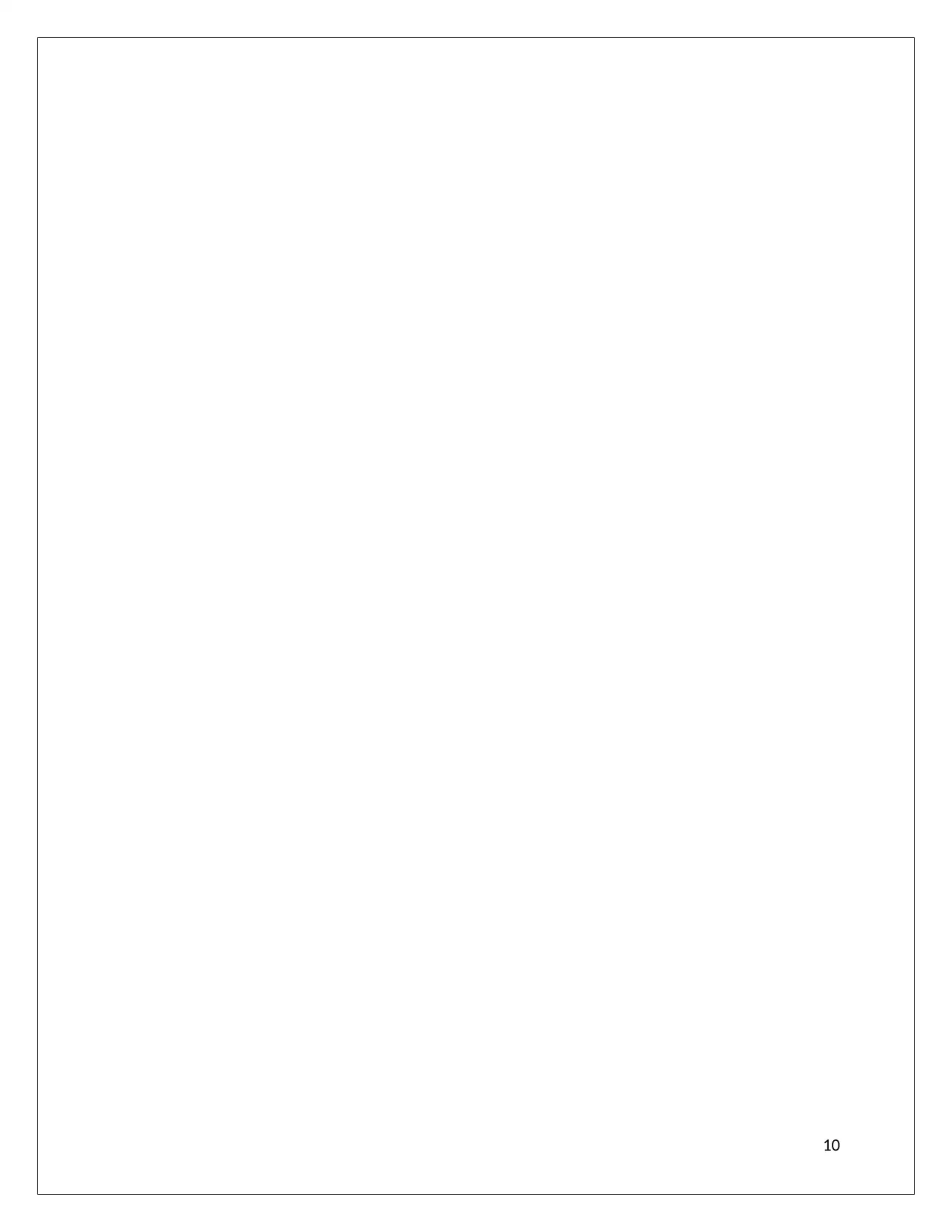
10
Paraphrase This Document
Need a fresh take? Get an instant paraphrase of this document with our AI Paraphraser

2) Prepare an Income Statement based on the calculations of costs as per the information
given above using both a) absorption costing method and b) marginal costing method.
Income statement as per marginal costing:
Income statement as per marginal costing
Particular Amount (₤)
Production units 800
Sales units 600
Sales @55 per unit 33000
Opening stock
Production cost: Variable
Direct material cost@ £7 per unit 5600
Direct labour @£ 6 per unit 4800
Other variable expenses @ £3 per unit 2400
Total Variable production cost 12800
Less: Closing stock 3200
Cost of goods sold 9600
Contribution 23400
Fixed Production Overhead 3200
Fixed Administration cost 1200
Fixed selling cost 1500
Net profit before tax 17500
11
given above using both a) absorption costing method and b) marginal costing method.
Income statement as per marginal costing:
Income statement as per marginal costing
Particular Amount (₤)
Production units 800
Sales units 600
Sales @55 per unit 33000
Opening stock
Production cost: Variable
Direct material cost@ £7 per unit 5600
Direct labour @£ 6 per unit 4800
Other variable expenses @ £3 per unit 2400
Total Variable production cost 12800
Less: Closing stock 3200
Cost of goods sold 9600
Contribution 23400
Fixed Production Overhead 3200
Fixed Administration cost 1200
Fixed selling cost 1500
Net profit before tax 17500
11
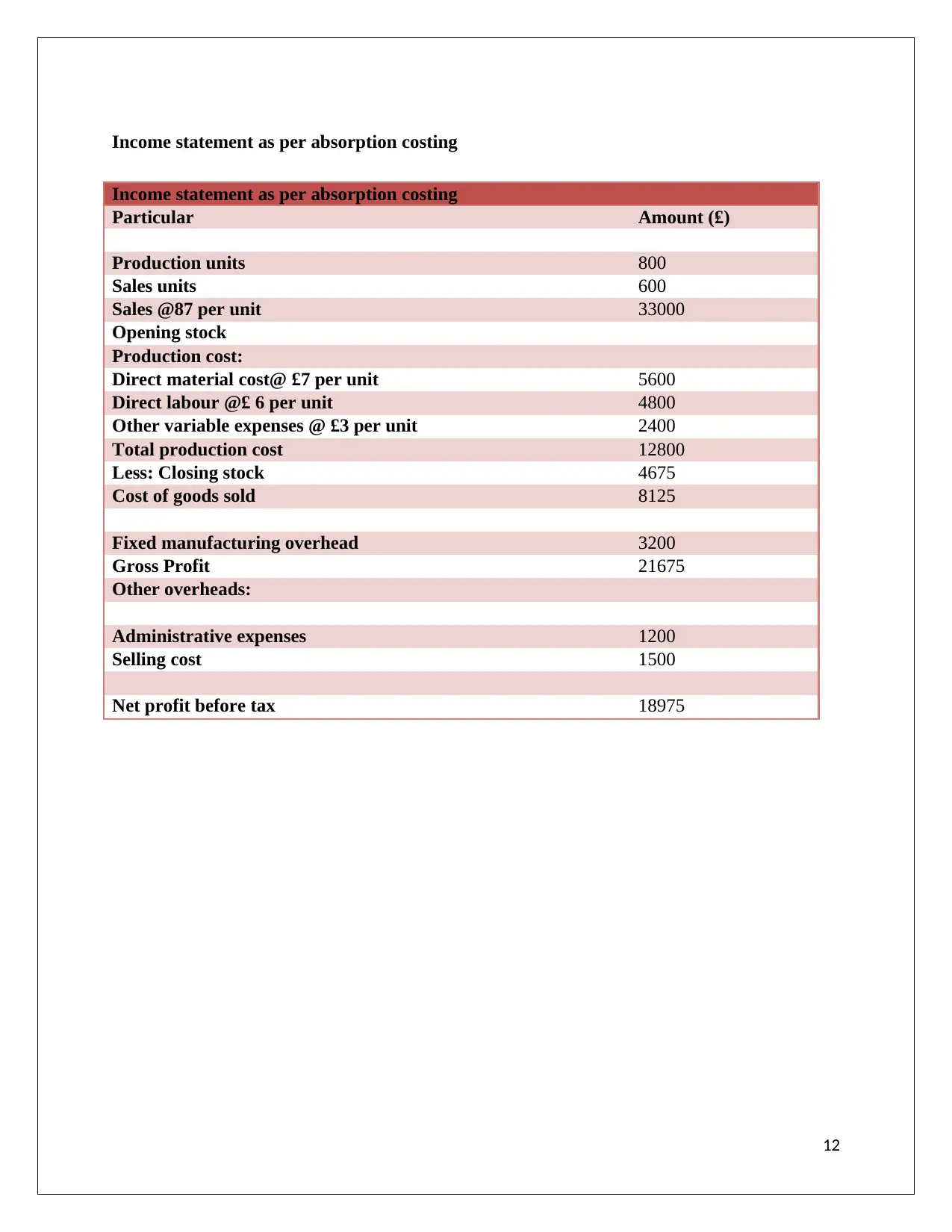
Income statement as per absorption costing
Income statement as per absorption costing
Particular Amount (₤)
Production units 800
Sales units 600
Sales @87 per unit 33000
Opening stock
Production cost:
Direct material cost@ £7 per unit 5600
Direct labour @£ 6 per unit 4800
Other variable expenses @ £3 per unit 2400
Total production cost 12800
Less: Closing stock 4675
Cost of goods sold 8125
Fixed manufacturing overhead 3200
Gross Profit 21675
Other overheads:
Administrative expenses 1200
Selling cost 1500
Net profit before tax 18975
12
Income statement as per absorption costing
Particular Amount (₤)
Production units 800
Sales units 600
Sales @87 per unit 33000
Opening stock
Production cost:
Direct material cost@ £7 per unit 5600
Direct labour @£ 6 per unit 4800
Other variable expenses @ £3 per unit 2400
Total production cost 12800
Less: Closing stock 4675
Cost of goods sold 8125
Fixed manufacturing overhead 3200
Gross Profit 21675
Other overheads:
Administrative expenses 1200
Selling cost 1500
Net profit before tax 18975
12
⊘ This is a preview!⊘
Do you want full access?
Subscribe today to unlock all pages.

Trusted by 1+ million students worldwide
1 out of 21
Related Documents
Your All-in-One AI-Powered Toolkit for Academic Success.
+13062052269
info@desklib.com
Available 24*7 on WhatsApp / Email
![[object Object]](/_next/static/media/star-bottom.7253800d.svg)
Unlock your academic potential
Copyright © 2020–2025 A2Z Services. All Rights Reserved. Developed and managed by ZUCOL.





